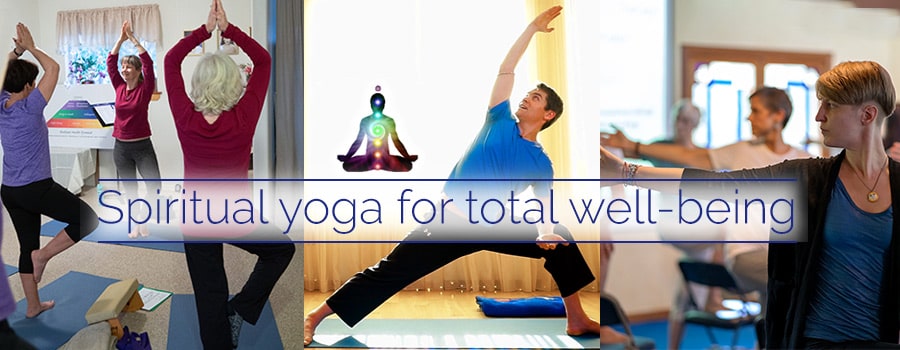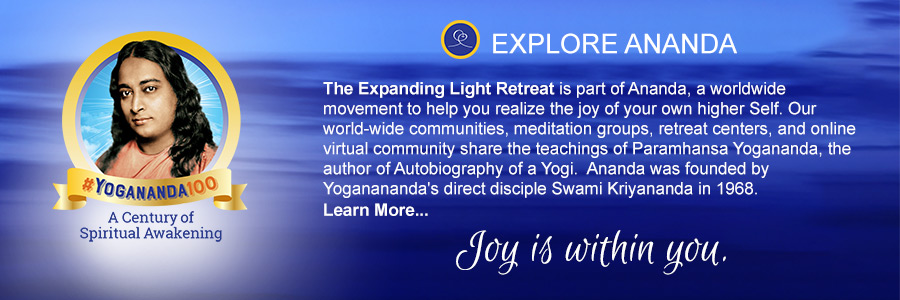How Can I Teach Different Levels of Yoga Students in the Same Class?
Question
I'm seeking ideas on dealing with students of different levels during drop in classes, especially “experienced” students. So far folks really love Ananda style yoga, but “experienced” folks often want more of a workout.
Answers

Savitri Simpson
Ananda Village, California
You may have heard me say in class that I believe that “different levels” is one of the most common and difficult to solve challenges, and one that every yoga teachers faces at one time or another.
I know that the “experienced” students are often the ones who are most vocal about what they are hoping to have happen in classes, based on other classes they have been to, or just pre-conceived expectations about what yoga is or should be. They tend to sway the instructor, who naturally wants the students to have a good experience, to edge over into making the classes fit into their ideas of what a "good workout" might be.
I believe that a good yoga session is not the same thing as a good workout class. If you want a good workout, go to an aerobics or other sort of strenuous exercise class. Yoga is designed to do something very different. It is an "energy control and energy movement workout" which is much more subtle, and in the long run can be even more effective than a physical workout in making their lives better in every way.
Yoga was designed to heal, center, and balance the body on an energetic level and to prepare the body and mind for meditation. As an Ananda Yoga® teacher, it is your job to convince your students (through how you present these concepts and through their own experiences in your classes) that true yoga is NOT what the popular concepts of yoga are, as they are usually presented (like another form of exercise).
Now this becomes much harder to do when the format is a "drop-in" one. So a couple of suggestions would be to always to try to arrange your students with beginners in front, mid-levels in the middle, and more advanced in the back. Tell the folks in front not to look back, but to look at you. Tell the folks in back to extend, lengthen, or modify the stretches in a deeper way as they feel to do so. Let the folks in the middle gravitate more "front-ward" as much as possible.
But if you are extremely magnetic in your presentation, explaining carefully what they are doing and what they are supposed to be feeling on an inward level, then probably the more advanced folks will be drawn in to experiencing the flow of yoga in a new and more deeply internal/spiritual way. To be magnetic in this way means to be convinced, down to your deepest level of being, that a more inward approach to yoga like Ananda yoga, is valid, extremely valuable, even life-changing!
Another suggestion is to begin each drop-in class with a "Posture of the Day." Spend a lot of time on it and show every possibility and nuance of the pose all modifications, etc, helping people to find the level at which they want to do the pose. Have a handout on this posture with diagrams, modifications, affirmation, suggestions, cautions, etc., and at the end of this part of the class, "tease" them with which posture you will cover in the next session, so they won't want to miss the in-depth look at that posture. Then go on with the rest of the class. This approach is usually very satisfactory to all levels of students.
And finally, the more you teach, the more you learn that you just can’t please everybody! Don't go there — it never works and makes you appear indecisive and wish-washy. I think it is good to know if there are other yoga teachers in your area and what type of yoga they are teaching, so you can refer a student along, if you feel that is needed.
At times I have done this, and then they go there for a while, then zoom on back to my classes, because there was something they were getting that, after time and other experiences, begin to feel valuable to them. Sometimes they go to lots of different classes, because they want different kind of experiences, and of course this is fine too.
I would stand strong with what you want to be as an Ananda Yoga teacher. The fads of power yoga and aerobic yoga and so on will come and go, but the deeper essence of yoga will (MUST!) remain true. I'd ride that wave, if I were you.
Julie Boone
Roseville, California
Teaching mixed level groups can be challenging and exciting. In my experience, networking with other local teachers and studios gives you the tools to refer students when appropriate.
I can have an "experienced" student hold poses longer, do shoulder stand while others are in bridge, and go deeper in the twists… but I'm never going to offer them the equivalent of a Vinyasa flow or Ashtanga series. It's only fair to them and to me to be clear about what I am offering rather than try to be everything to everyone.
I find that the referrals work both ways. Other teachers know that I'm the one to call for people who want to go more inward and work safely with special needs.
I share yoga philosophy with my students as appropriate, reminding them that mindfulness, pranayama, and meditation are the most "advanced" forms of yoga. I go out of my way to honor and praise them for "driving their sports cars in 2nd gear" i.e. taking the time to actually be actively calm and calmly active. That IS what the experienced yogi aspires to.
All of this isn't to say that I don't challenge my students. I do encourage them to come right to the edge as appropriate. (Just ask them... whew!) I just try to strike a middle note for the whole class... that generally means that some are working at 100% capacity and others are working at 75% capacity. In my way of thinking, if I brought the whole group to 100% capacity, 25% of them would be working past their limits and risking injury.
This is not a one size fits all approach. I will show a pose with 4 different levels. In a group of 15, I might have 9 doing seated 1/2 spinal twist with one leg straight, one knee bent and the foot stepped over the straight leg. 2 might have the straight leg bent (sitting on the foot) and going deeper using the arms more. The remaining 4 might be doing a supine twist or an "open" twist (turning the spine the other way).
The Ananda Yoga Teacher Training Assistantship program will give you so many tools for modifying postures as needed.

Mark Beach
Kekaha, Kauai, HI
Swami Kriyananda has talked about the importance of balance in our practice of the different techniques. When there is balance between asana, pranayama and meditation we find a place of surrender, we are not trying to "accomplish " something we are present to receive the blessing of the moment.
I have had "experienced " students request more of a workout. I brought them back to such basics as proper breathing. (Many students with 20 plus years are still breathing upside down, or "chest breathing") sitting comfortable and steady in a simple seated pose, and the wonder of Ujaii breathing while doing the most basic posture. In most every instance they discovered how little they actually knew about basics.
Ananda Yoga is about the way in which it helps our meditation. Some people will try to quiet the senses with extreme posturing, it might be right for them in their present state of development, but hold steady with the basics and remember that we are trying to quiet the mind, not enervate the bodily systems to the point of further distraction. I hope this is of some help.
Butchi Smith
Bluffton, South Carolina
When I have a more advanced student in class I tell them to do the more advanced versions of poses and less adept students I reiterate that they must listen to their bodies and modify or ask me to help them with a modification.
I also frequently remind students that the perfect asana is the simplest one done with complete awareness. And then the truth is Ananda Yoga is not for everyone. Some people are better in an Ashtanga class or what ever. Then there are those who are looking at yoga as just another exercise class and they may just as well be at the gym.
I try to be up front with new students and let them know that I teach yoga as a spiritual practice and I emphasize that doesn't mean religious. I have had very few students that didn't find that they loved Ananda Yoga regardless of what lineage they came from. I have never taken a class that I didn't learn something regardless of what level class I was taking.
Ask your students to come with a beginners mind and open to possibility. Teach from your heart and all else falls into place. The students who come to your class are suppose to be there or they wouldn't be there. It's up to them what they get out of it.
Related Articles
All authors are graduates of Ananda Yoga Teacher Training.




















